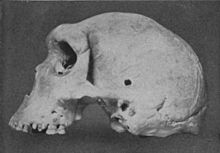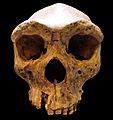Homo rhodesiensis facts for kids
Homo rhodesiensis is the name given to an ancient human species. Scientists described it from a single fossil skull. This skull was found in 1921 at a mine called Broken Hill. This mine was in a place then known as Northern Rhodesia, which is now Zambia.
The skull is almost complete, but it is missing the lower jaw. Along with the skull, parts of an upper jaw from another individual were found. Scientists also found a sacrum (a bone from the pelvis), a tibia (shin bone), and two pieces of a femur (thigh bone).
Quick facts for kids Homo rhodesiensisTemporal range: Pleistocene
|
|
|---|---|
 |
|
| Skull found in 1921 | |
| Scientific classification | |
| Domain: | |
| Kingdom: | |
| Phylum: | |
| Class: | |
| Order: | |
| Family: | |
| Tribe: | |
| Genus: | |
| Species: |
H. rhodesiensis
|
| Binomial name | |
| †Homo rhodesiensis Woodward, 1921
|
|
Contents
How Old Is It?
Scientists believe the skull, often called "Rhodesian Man," is between 125,000 and 300,000 years old. One study in 1974 suggested it was about 110,000 years old.
The brain size of this skull is estimated to be about 1,100 cubic centimeters. This is a bit small for a human from such a recent time period. Sadly, the place where the skull was found has been destroyed. This makes it impossible to do more modern dating tests on the layers of earth.
What Did Homo rhodesiensis Look Like?
The skull shows that this individual was very strong and sturdy. It has the largest brow-ridges (the bony ridges above the eyes) of any known human-like fossil.
Scientists have described its face as wide, similar to Neanderthals (Homo neanderthalensis). This means it had a large nose and thick, sticking-out brow ridges. Because of this, some people used to call it an "African Neanderthal."
Relationship to Other Human Species
Many features of Homo rhodesiensis are a mix between modern humans (Homo sapiens) and Neanderthals. Most experts today think that Homo rhodesiensis belongs to the group called Homo heidelbergensis.
Other names have also been suggested for this species. These include "Archaic Homo sapiens" and "Homo sapiens rhodesiensis."
Images for kids
See also




